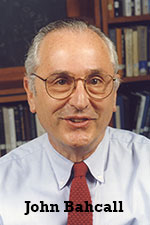Special Physics Colloquium: The John Bahcall Astrophysics Lecture
"FIFTY YEARS OF SPIRAL DENSITY WAVE THEORY"
Professor Frank Shu, National Tsing Hua University, Taiwan

The Emilio Segre Distinguished Lectures in Physics of the Raymond and Beverly Sackler Foundation
The John Bahcall Lecture in Astrophysics– 2013/2014
Introductory Remarks: Prof. Dan Maoz, Astrophysics Department
Presentation:
The John Bahcall Fellowship to
Mr. Ofer Doron, undergraduate Physics student
The John Bahcall Astrophysics Prize to Mr. Simchon Faigler, Ph.D student
Abstract:
This year marks the fiftieth anniversary of the publication of the paper "On the Spiral Structure of Disk Galaxies" by C. C. Lin and Frank H. Shu. How well has it fulfilled its promise to explain the systematics of the Hubble sequence of spiral and barred spiral galaxies (which John Bahcall regarded as its most attractive theoretical feature)?
In this talk, I review the linear and nonlinear theory of spiral density waves, starting from the hypothesis of quasi-stationary spiral structure (QSSS), its observational consequences and early tests, before moving to the theory of resonantly forced spiral density waves and its applications to structure formation in planetary rings, planet migration in protoplanetary disks, and bar forcing in the central regions of active galaxies with supermassive black holes. Adopting the QSSS hypothesis, we also study the development of parasitic, self-gravitating, magnetohydrodynamic instabilities that can develop secondary spiral-arm structures such as branches, spurs, and feathers. The last may revolutionize our conception of objects such as giant molecular clouds. I then discuss spontaneously growing normal modes based on the concepts of (1) spiral density waves with negative and positive densities of wave energy and angular momentum, (2) over-reflection at corotation by the mechanisms of wave-amplification by the stimulated emission of radiation (WASER) and Swing, and (3) feedback from the central regions. New semi-analytic results, numerical simulations, and observations in the near-infrared of grand-design and flocculent spiral galaxies, suggest that growing stellar density waves can saturate by nonlinear effects, thereby supplying the missing justification for the original QSSS hypothesis.


